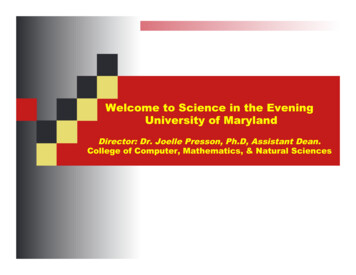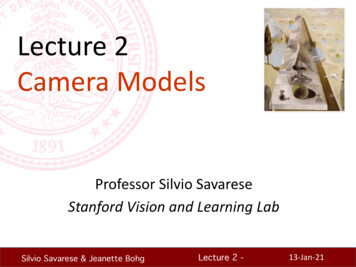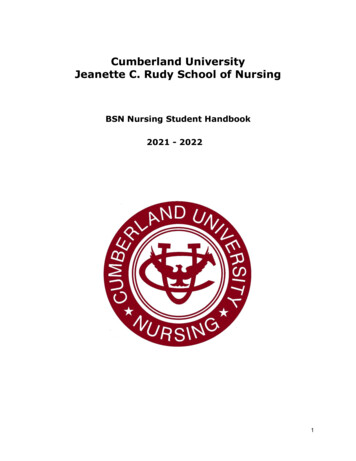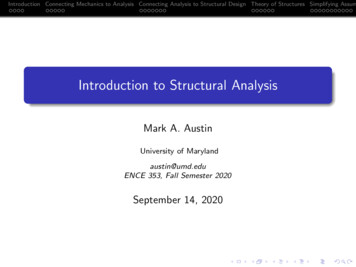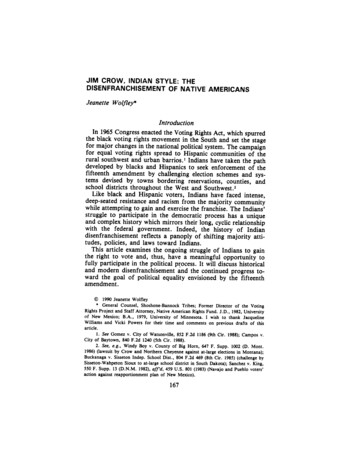
Transcription
JIM CROW, INDIAN STYLE: THEDISENFRANCHISEMENT OF NATIVE AMERICANSJeanetteWolfley.IntroductionIn 1965Congressenactedthe Voting Rights Act, which spurredthe black voting rights movement in the South and set the stagefor major changesin the national political system.The campaignfor equal voting rights spread to Hispanic communities of therural southwest and urban barrios.! Indians have taken the pathdeveloped by blacks and Hispanics to seek enforcement of thefifteenth amendment by challenging election schemesand systems devised by towns bordering reservations, counties, andschool districts throughout the West and Southwest.2Like black and Hispanic voters, Indians have faced intense,deep-seatedresistanceand racism from the majority communitywhile attempting to gain and exercisethe franchise. The Indians'struggle to participate in the democratic process has a uniqueand complex history which mirrors their long, cyclic relationshipwith the federal government. Indeed, the history of Indiandisenfranchisement reflects a panoply of shifting majority attitudes, policies, and laws toward Indians.This article examines the ongoing struggle of Indians to gainthe right to vote and, thus, have a meaningful opportunity tofully participate in the political process. It will discusshistoricaland modem disenfranchisementand the continued progress toward the goal of political equality envisioned by the fifteenthamendment.@ 1990 Jeanette Wolfley.General Counsel, Shoshone-BannockTribes; Former Director of the VotingRights Project and Staff Attorney, Native American Rights Fund. J.D., 1982, Universityof New Mexico; B.A., 1979, University of Minnesota. I wish to thank JacquelineWilliams and Vicki Powers for their time and comments on previous drafts of thisarticle.1. See Gomez v. City of Watsonville, 852 F.2d 1186 (9th Cir. 1988); Campos v.City of Baytown, 840 F.2d 1240 (5th Cir. 1988).2. See, e.g., Windy Boy v. County of Big Horn, 647 F. Supp. 1002 (D. Mont.1986) Oawsuit by Crow and Northern Cheyenne against at-large elections in Montana);Buckanaga v. Sisseton Indep. School Dist., 804 F.2d 469 (8th Cir. 1985) (challenge bySisseton-WahpetonSioux to at-large school district in South Dakota); Sanchezv. King,550 F. Supp. 13 (D.N.M. 1982), a/I'd, 459 U.S. 801 (1983)(Navajo and Pueblo voters'action against reapportionment plan of New Mexico).167
168AMERICAN INDIAN LA W REVIEW[Vol. 16Imposition of Naturalization and CitizenshipIn the past 200 years, federal Indian policy has beena productof tension between two conflicting res,ponsesto the "Indianproblem"-separation and assimilation. One federal policy coerced Indians to adopt and integrate into the mainstream whitemajority, while another obstructed their participation in thegrowing American society. The struggle over Indian voting rightsillustrates these two policies.Naturalization and citizenship laws were major mechanismsto facilitate federal efforts to assimilate Indians, obtain Indianlands, and terminate tribal governments. From 1854 to 1924,naturalization and citizenship were the primary devices used toinduce assimilation. As this article will show, these federal efforts were not readily accepted by the majority society andIndians.3The common objectives of the majoritys' views stemmed fromthe principles articulated by Chief Justice Marshall in his threelandmark opinions, known as the Marshall Trilogy: Johnson v.M'Intosh,4 Cherokee Nation v. Georgia,"'and Worcesterv. Georgia.6 These casestreated Indian tribes as distinct, independent3. See,e.g., In re Heft, 197U.S. 488, 499-502(1905), overruled sub nom. UnitedStatesv. Nice, 241 U.S. 591 (1916).4. 21 U.S. (8 Wheat.) 543 (1823). In this decision, the Court held as invalid tribalconveyanceof land to private individuals. The Court reasoned that Indians retained aright of occupancy extinguishable by discovering European sovereigns. The result wasa recognition of a legal right of Indians in their lands valid against all parties save thefederal government.5. 30 U.S. (5 Pet.) 9 (1831). Cherokee Nation expanded the recognition of Indiansovereignty set forth in Johnson v. M'lntosh. Georgia attempted to impose its laws onthe Cherokees in violation of treaty provisions. To stop such intrusions, the Cherokeefiled suit in the Supreme Court under article III, section 2 of the United StatesConstitution-a section which gives the Supreme Court original jurisdiction in casesandcontroversies involving states and foreign nations. ld. at 7-14. The key issue before theCourt was whether the Cherokees constituted a "foreign nation" in the Constitutionalsense. Chief Justice Marshall determined that they did not. However, Marshall determined that the tribe was a state in the international sense; it was "a distinct politicalsocietyseparatedfrom others, capableof managing its own affairs and governing itself."ld. at 16. Marshall noted that the tribe was "in a state of pupilage," and "theirrelations with the United States resemblesthat of a ward to his guardian." ld. at 17.6. 31 U.S. (6 Pet.) 515, 528 (1832). The following term, Justice Marshall addressedthe unresolvedissueof state jurisdiction over Indian tribes. Georgia attempted to preventnon-Indians from living on Cherokeelands without permission of the State's Governor.In a strongly-worded opinion, Marshall struck down the application of Georgia law toCherokeelands, stating: "The Cherokee nation, then, is a distinct community, occupyingits own territory, with boundaries accurately described, in which the laws of Georgiacan have no force." ld. at 561. Marshall's opinion is the foundation of law excludinga states' law from Indian Country.
No.1]JIM CROW, INDIAN STYLE169political communities. As seen below, this treatment has sinceraised questions of dual citizenship, wardship, and competency.NaturalizationIn Marshall's understanding, Indian tribes possesseda sovereignty as complete as that of any European nation. After forming political alliances through treaties with the United States,tribes surrendered their sovereignty but remained sovereigns inthe sense the term has been used since the early nineteenthcentury.7 Prior to the General Allotment Act of 1887,8 mostIndians were considered members of separate political communities and not part of the state politic or the United States.9Theterm "sovereign" is used to describe the status of tribal governments, and it is acknowledged by the United States SupremeCourt as a fundamental of modem federal law. 10Despite the Marshall Trilogy, the settlers' demand for Indianlands increased rapidly and forced politicians to develop a policyof removal. West of the Mississippi River lay vast amounts ofpresumably unoccupied lands; by pushing Indians beyond theriver settlers would possessthe land.The popularity of removal was so strong that the federalgovernment embarked on a campaign of negotiating removaltreaties even before President Andrew Jackson signed the IndianRemoval Act of 1830.11Removal was more than an assault on7. Tribal sovereigntyas recognized in Worcesteris best described by Felix Cohen:The whole course of judicial decision on the nature of Indian tribal powersis marked by adherence to three fundamental principles: (I) An Indiantribe possess,in the first instance, all the powers of any sovereign state,(2) Conquest renders the tribe subject to legislative power of the UnitedStates, and, in substance,terminates the external powers of sovereignty ofthe tribe, e.g., its power to enter into treaties with foreign nations, butdoes not, by itself, affect the internal sovereignty of the tribe, i.e., itspower of local self-government, (3) thesepowers are subject to qualificationby treaties and by express legislation of Congress, but, save as thusexpressly qualified, full powers of internal sovereignty are vested in theIndian tribes and in their duly constituted organs of government.F. COHEN,HANDBOOKOFFEDERALINDIAN LAW 123 (1942 ed.8. See infra note 56 and accompanying text.9. SeeCherokee Nation v. Georgia, 30 U.S. (5 Pet.) I (1831); The Kansas Indians72 U.S. (5 Wall.) 737 (1866); United Statesv. Kagama, 118 U.S. 375 (1886).10. In modern times, the Supreme Court has held that tribal governments are"unique aggregations possessingattributes of sovereignty over both their members andtheir territory." See, e.g., United States v. Wheeler, 435 U.S. 313 (1978).11. Ch. 148,4 Stat. 411 (current version of §§ 7-8 at 25 U.S.C. § 174(1988». TheAct authorized President Jackson to exchange territory west of the Mississippi Riverfor the lands of eastern tribes. For further discussion, see F. COHEN,HANDBOOKOFFEDERALINDIAN LAW 78-92 (1982 ed.).I
170AMERICAN INDIAN LA W REVIEW[Vol. 16Indians; many believed that the removal policy was the onlymeansof saving Indians from extermination. Removal eventuallyservedto promote assimilation, albeit assimilation by separation.In conjunction with removal, the federal government createdthe reservation, a strategy which sought to change Indian tribespolitically, socially, and economically.12Instead of their traditional tribal leadership, most tribal members found themselvessubject to the authority of white agents from the Bureau ofIndian Affairs (BIA). However, many reformers saw the reservations as cultural failures; others as economic failures or obstaclesto progress. For example, railroads were acceleratingtheirdemand for Indian lands and cattle ranchers made similar demands.With the reservation policy clearly not working, reformersabandoned it and launched a triple assaulton Indian sovereignty:the creation of a federal school system for Native Americans,l)the extension of federal laws to Indians,14and the allotment oftribal lands. ISBy splintering the reservations and distributing the land inallotments to individual Indians, the reformers hoped to destroytribal economic power and assimilate Indians to European-American commercial values. It was intended that when tribal economic power was eliminated, tribal political power would alsowane; the reformers would then grant United States citizenshipto allotted Indians. Thus, federal supervision of Indians wouldbecome unnecessary.The reformers believed economic self-sufficiency, legal subjugation, and assimilation was the solution tothe "Indian problem."Most reformers agreed that assimilation was the ultimate solution, and a structured education, an allotment policy, andUnited States citizenship were the most effective ways to bringit about. Some reformers wanted assimilation immediately: railroads, oil companies, homesteaders and cattle ranchers demanded immediate placement of Indian children in schools,award of citizenship, and allotment of tribal land. Other re12. See ch. 85, 3 Stat.516 (1819) (currentversion of § 1 at 25 V.S.C.§ 271(1988».13. Education for Indians was provided by mission schools in the early days.Beginning in the late 1870s, off-reservation boarding schools were established. In theeyes of reformists, off-reservation boarding schools were the ideal method of assimilationbecause Indian youth were removed from their families. See SPECIAL SUBCOMM. ONINDIAN EDUCATION, A NATIONAL TRAGEDY-A NATIONAL CHALLENGE,S. REP. No. SOl,91st Cong., 1st Sess. 140-52 (1969).14. See F. PRUCHA, AMERICAN INDIAN POLICY IN CRISIS 328-41 (1976).IS. See infra text accompanying notes 16-17, 44-50, & 57-60.
No.1]JIM CROw, INDIAN STYLE171formers insisted on a more gradual approach that emphasizedcitizenship and allotment only when an Indian was culturallyprepared for both. Between 1880 and 1934, policy toward Indians vacillated between these extremes.Congressional efforts to naturalize entire tribes generally fellshort of their intended goal. For example, from 1839 to 1850,the Stockbridge-Munsee,Brotherton, and Wyandot Indians wereplagued with incessant congressional efforts to make them citizens.16In other congressional attempts, citizenship was madedependent upon the acceptance of an allotment of land; thealternative to accepting an allotment was removal from nativelands.11Indians who were not granted citizenship by congressionalaction were barred from the naturalization process open toEuropean immigrants; Indians were regarded as domestic subjects or nationals. ISThis concept of Indian status was reiteratedby United States Attorney General Caleb Cushing in 1856:19The fact, therefore, that Indians are born in the country does not make them citizens of the United States.The simple truth is plain, that Indians are subjects ofthe United States, and therefore are not, in mere rightof home-birth, citizens of the United States.But they cannot become citizens by naturalization under existing general acts of Congress.Those acts applyto foreigners, subjects of another allegiance. The Indians are not foreigners, and they are in our allegiance,without being citizens of the United States. Moreover,those acts only apply to "white" men.16. See Act of Mar. 3, 1839, ch. 83, 5 Stat. 349, 351 (Brotherton); Act of Mar.3, 1843,ch. 101, § 7, 5 Stat. 645, 647 (Stockbridge); Act of August 6, 1846,ch. 85, 9Stat. 55 (Stockbridge); Treaty with the Senecas[and Others], Feb. 23, 1867,art. 13, 15Stat. 513, 516 (tribal signatories included the Senecas,Shawnees,Quapaws, and Wyandots). Article 13 of the treaty with the Senecasprohibited tribal membershipto Wyandotswho had consented to United States citizenship under a prior treaty unless they werefound "unfit for the responsibilities of citizenship." Id.17. See Treaty with the Pouawatomie Indians, Feb. 27, 1867, United StatesPouawatomies, art. 6, 15 Stat. 531, 531-33; Treaty with the Sioux Indians, Apr. 29,1868, United States-Sioux, art. 6, 15 Stat. 635, 637; Treaty with the Choctaws, Sept.27, 1830,United States-Choctaws,arts. 14, 16, 7 Stat. 333, 335-36.18. See In re Camille, 6 Fed. 256 (C. Or. 1880); In re Burton, I Alaska III (D.Alaska 1900). Camille is a prime example of the deep-seatedracism held by manywhites, and certainly by the judiciary, against nonwhite persons in the late 1800s.19. 7 Op. AU'y Gen. 746 (1856).
172AMERICAN INDIAN LA W REVIEW[Vol. 16Indians, of course, can be made citizens of the UnitedStates only by some competent act of the GeneralGovernment, either a treaty or an act of Congress.20In the early citizenship case of Scott v. Sanfordll (the DredScott Case), the Supreme Court held that a black person couldnot become a citizen under the Constitution.22 The SupremeCourt stated, in dictum, that Indians were not citizens, in theconstitutional sense, but that Congress had the power to naturalize Indians.23Thus, the Dred Scott Case effectively concludedthat Indians who were unable to prove they were born underUnited States jurisdiction24 were precluded from registering tovote.Although Congress did eventually naturalize all Indians, before the Reconstruction Era2 the general naturalization lawswere restricted to European immigrants and did not includenative-born Indians.26 In 1868, section I of the fourteenthamendment defined citizenship as "all persons born or naturalized in the United States, and subject to the jurisdiction thereof,are citizens of the United States. ."2720. ld. at 749-50.21. 60 U.S. (19 How.) 393 (1857).22. ld. at 403-04. This notorious decision was legislatively overridden by the CivilRights Act of 1866, ch. 31, § I, 14 Stat. 27, 27.23. Scott, 60 U.S. (19 How.) at 403-04.24. See infra note 29 and accompanying text.25. After the Civil War, the First Reconstruction Act of 1867mandated that theConfederate States, in order to reenter the Union, had to adopt new constitutionsguaranteeing male suffrage without regard to race. Act of Mar. 2, 1867, ch. 153, 14Stat. 428. Subsequently, Congress adopted the fifteenth amendment in 1870, whichguarantees the right to vote irrespective of .'race, color, or previous condition ofservitude." U.S. CONST.amend. XV, § 1.26. SeeAct of Apr. 14, 1802, ch. 28, 2 Stat. 153. Indians born in Canada, Mexico,or other foreign countries did not become eligible for citizenship until the adoption ofthe Nationality Act of 1940, ch. 876, § 303, 54 Stat. 1137, 1140,supersededby Act ofJune 27, 1952, ch. 477, § 301, 66 Stat. 163, 235 (codified at 8 U.S.C. § 1401 (1952»,becausethe Citizenship Act of 1924referred only to "Indians born within the territoriallimits of the United States." Act of June 2, 1924, ch. 233, 43 Stat. 253, 253. SeeMorrison v. California, 291 U.S. 82, 95 n.5 (1934).27. U.S. CONST.amend. XIV, § I:All persons born or naturalized in the United States, and subject to thejurisdiction thereof, are citizens of the United States and of the statewherein they reside. No state shall make or enforce any law which shallabridge the privileges or immunities of citizens of the United States' norshall any state deprive any person of life, libeny, or property, withoutdue process of law; nor deny to any person within its jurisdiction theequal protection of the laws.
No.1]JIM CRO W, INDIAN STYLE173Following passageof the amendment,some erroneouslythoughtIndians automatically qualified for United States citizenship because of the phrase "all persons," and because Indians werenot explicitly excluded. This dispute prompted the Senate toinstruct the Senate Judiciary Committee to inquire into the statusof Indians under the amendment.28In December, 1870, the Senate Judiciary Committee reportedthat Indians who maintained their tribal relations were notcitizens under the fourteenth amendment. Therefore, they couldnot be said to have been born under the complete jurisdictionof the United States.29The Committee had the view that citizenship was incompatible with continued participation in tribalgovernment or tribal property. That is, citizenship required affirmative consentto jurisdiction of the United States. The reportstated:To maintain that the United States intended, by achange of its fundamental law, which was not ratifiedby these tribes, and to which they were neither requested nor permitted to assent, to annual treatiesthen existing between the United States as one party,and the Indian tribes as the other parties respectively,would be to charge upon the United States repudiationof national obligations, repudiation doubly infamousfrom the fact that the parties whose claims were thusannulled are too weak to enforce their just rights, andwere enjoying the voluntarily assumed guardianshipand protection of this Government.30One year later, an Oregon district court agreed with the JudiciaryCommittee and held that Indians born in tribal allegiance werenot persons born in the United States and thus subject to itsjurisdiction.31 The court stated:To be a citizen of the United States by reason of hisbirth, a person must not only be born within itsterritorial limits, but he must also be born subject toits jurisdiction-thatis, in its power and obedience. .Butthe Indian tribes within the limits ofthe United States have always been held to be distinct28. CONGoGLOBE,41st Cong., 2d Sess. 2479 (1870) (text of the resolution ofinquiry).29. SEN. REp. No. 268, 41st Cong., 3d Sess. I-II (1870).30. [d. at II.31. McKay v. Campbell, 16 F. Cas. 161 (D. Or. 1871)(No. 8840).
174AMERICAN INDIAN LA W REVIEW[Vol. 16and independent political communities, retaining theright of self-government, though subject to the protecting power of the United States.32This position was sustained by a subsequentUnited States Supreme Court naturalization case, Elk v. Wilkins. 33Elk representsa torturous interpretation of state statutes andconstitutional amendments in order to prevent Indians fromvoting. John Elk left his tribe and resided in Omaha, Nebraska.He attempted to exercise his right to vote in Nebraska. TheCourt, in upholding the denial of his right to vote, reasonedthat he was not an American citizen becausehis intent to becomea citizen required a positive and specific response from theUnited States before it could affect his status as a citizen.34The Court further concluded that the fifteenth amendmentdid not apply to Elk, nor was he a United States citizen becausehe did not owe allegiance to the United States.35A final reasonfor denying the right to Elk was that the United States hadentered into treaties and enacted statutes (before and after thefourteenth amendment) naturalizing particular tribes and portions of tribes.36Therefore, the federal government had otherlegislative means of naturalizing Indians.The majority opinion chose to disregard that Elk had severedrelations with his tribe.3?The Court construed section 1 of thefourteenth amendment as requiring a person deemed a citizenby birth to be subject to the ordinary jurisdiction of the UnitedStates at the time of birth.38 Since Elk was born to a tribalmember who lived on tribal land, he was not a citizen by birth.32. Id. at 165-66.33. 112 U.S. 94 (1884).34. Elk, 112 U.S. at 109.35. Id. at 99. The Court also relied on the fourteenth amendment phraseology,"Indians not taxed," to deny the franchise to Elk. Section 2 of the fourteenth amendment provides: "Representatives shall be apportioned among the severalStatesaccordingto their respective numbers, counting the whole numbers of persons in each state.excluding Indians not taxed." U.S. CONST.amend. XIV, § 2 (emphasis added). Asimilar provision is found elsewherein the Constitution. Id. art. I, § 2, cl. 3. In 1926,when § I was codified, the phrase "Indians not taxed" was deleted. See 8 U.S.C. § I(1926).36. Elk, 112 U.S. at 108-09.37. Elk lived outside Indian Country within Nebraskaand was subject to state andfederal taxation.38. Id. See also United States v. Osborn, 2 F. 58 (D. Or. 1880). For a study ofthe effects of tribal membership on citizenship, see Katzenmeyerv. United States, 225F. 501, 523 (7th Cir. 1915).
No.1]JIM CROW, INDIAN STYLE175The Elk dissenting opinion by Judge Harlan is better reasoned.39The dissent points out that the legislative history of thefourteenth amendmentdemonstratesthe drafters understoodthoseIndians, such as Elk, who were considered citizens pursuant tosection 1.40The dissent further argued that prior to the fourteenth amendment Congress had granted citizenship to manyIndians who abandoned their tribal ties.41The dissent also notedthat the 1870 Senate Judiciary Committee report supported Indian citizenship under the fourteenth amendment, and thatthe report closes with this significant language: "It ispertinent to say, in concluding this report, that treatyrelations can properly exist with Indian tribes or Nationsonly, and that when the members of any Indian tribeare scattered, they are merged in the mass of ourpeople and become equally subject to the jurisdictionof the United States."42To the advocates of immediate citizenship, the Elk decision wasan outrage.43An English-speaking farmer and family man, Elkwas acculturated to European-American society and was certainly deserving of citizenship. Something had to be done, andthe advocatesfor gradual citizenship were pressuredinto mergingthe question of Indian citizenship with their drive for the allotment of tribal lands.Following Elk, the legal status of Indians representeda stateunknown to civil law: Indians were neither citizens nor aliens;they were not white under the naturalization laws, or slaves, orpersons in a previous condition of servitude.44Barring specialacts, treaties, or a constitutional amendment, many Indiansappearedto exist in a legal vacuum.Indian CitizenshipAlthough John Elk was never naturalized, thousands of Indians were naturalized from the mid-1850s through the early39. Elk, 112 U.S. at 112-19(Harlan, J., dissenting).40. [d. at 117-18. Significantly, the majority ignored the legislative history.41. [d. at 115-16.42. [d. at 119.43. In an Asian-American naturalization case, United States v. Wong Kim Ark,169 U.S. 649 (1898), the Supreme Court again found that Indians were not citizens.The Court excepted from its theory of citizenship by birth "members of Indian tribesof which owed immediate allegiance to their several tribes and were not part of thepeople of the United States. ."[d. at 662 (dictum).44. The status of Indians was overshadowed at the end of the Civil War by thediscussionand efforts for blacks to gain freedom, citizenship, and economic conditionsequal to whites.
176AMERICAN INDIAN LA W REVIEW[Vol. 161900s. By accepting allotments and leaving the reservation ortribal society, Indians were rewarded with citizenship. By 1924,nearly two-thirds of all Indians were granted citizenship bytreaties or special and general statutes.4sTreaties and Special ActsThe southeastern tribes were the first to receive citizenshipthrough their treaties with the United States.46In some treaties,citizenship was dependenton acceptanceof an allotment of landin severalty.47Indeed, in Elk, the Court identified twelve treaties,four statutes, four judicial opinions, and eight attorney generalopinions that required "proof of fitness for civilization" beforean Indian could obtain citizenship and the right to vote.48Many tribes were naturalized by special statute. In the casesof the Stockbridge and Brotherton Tribes of Wisconsin, thetribes were dissolved and land distributed to the members. Onceallotment was complete, the Indians became citizens.49Citizenship was also premised on the requirements that Indians adoptthe habits of "civilized life": learn to read and speak English.soAnother general act granted citizenship to Indian women whomarried white men.slIn 1890, as an enticement to members of the Five CivilizedTribess2to abandon their tribal relations, Congress passed theIndian Territory Naturalization Act.s3 The Act provided45. SeeD. MCCOOL,INDIAN VOTING106 (1985).46. Treaty with the Cherokees, July 8, 1817, United States-Cherokees,an. 8, 7Stat. 156, 159; Treaty with the Cherokees,Feb. 27, 1819, United States-Cherokees,an.2, 7 Stat. 195, 196; Treaty with the Choctaws, Sept. 27, 1830,United States-Choctaws,art. 14, 7 Stat. 333, 335. See F. COHEN,supra note 8, at 153 nn. 6-10, for treatiesconferring citizenship on tribes and individual Indians.47. See Treaty with the Kickapoos, June 28, 1862,an. 3, 13 Stat. 623, 624; Treatywith the Senecas[and Others], Feb. 23, 1867,an. 13, 15 Stat. 513, 516 (treaty betweenthe United States and the Senecas,Shawnees,Quapaws, Wyandots and others).48. Elk, 112 U.S. at 100.49. See Act of Mar. 3, 1839, ch. 83, 5 Stat. 349, 351 (Brotherton); Act of Mar.3, 1843, ch. 101, § 7, 5 Stat. 645, 647 (Stockbridge).50. Act of Mar. 3, 1865, § 4, 13 Stat. 541, 562. See Oakes v. United States, 172F. 305 (8th Cir. 1909).51. Act of Aug. 9, 1888,ch. 818, 25 Stat. 392.52. The Seminole, Choctaw, Chickasaw, Cherokee, and Creek Nations.53. Act of May 2, 1890, § 43, 26 Stat. 81, 99-100. The Five Civilized Tribesopposed the grant of federal citizenship to their people becausethey feared it wouldterminate their tribal government. See S. MISC. Doc. No.7, 45th Cong., 2d Sess.(Dec.1877) (vol. I). Significantly, the Five Civilized Tribes were excluded from the GeneralAllotment Act of 1887, §§ 6, 8, 24 Stat. 388, 390-91.
No.1]JIM CROW, INDIAN STYLE177[t]hat any member of any Indian tribe or nation residing in the Indian Territory may apply to the UnitedStates court therein to become a citizen of the UnitedStates, and such court shall have jurisdiction thereofand shall hear and determine such application as provided ., .[t]hat the Indians who become citizens ofthe United States under provisions of this Act do notforfeit or lose any rights or privileges they enjoy orare entitled to as members of the tribe or nation towhich they belong,S4The Act is similar to statutes enacted for specific tribes.ssAlso,more than any other federal legislation, it implies that Indianshold dual citizenship. However, it also reaffirms the potentialincompatibility between tribal membership and United Statescitizenship.The Allotment PeriodIn 1887,Congresspassedthe most disastrous Indian legislationin United States history: the General Allotment Act of 1887(GAA).S6The GAA had dual goals of opening Indian lands forwhite settlementS1and assimilating Indians into mainstream society.s8Assimilation was accomplished by imposing citizenship upontwo classesof Indians: (1) those to whom allotments were madeby the GAA, or any law or treaty, and (2) those who voluntarilylived apart from their tribes and "adopted the habits of civilizedlife."s9 Under the first instance, citizenship was automatic at the54. Act of May 2, 1890, § 43,26 Stat. 81,99-100.55. See, e.g., Act of July IS, 1870, § 10, 16 Stat. 335, 361-63. Under this act, aMinnesota Winnebago could apply to the federal district court for citizenship. See alsoAct of Mar. 3, 1873, § 3, 17 Stat. 631, 632.56. Ch. 199,24 Stat. 388 (codified at 25 U.S.C. §§ 331-34, 339,341-42, 348 (1982»[hereinafter GAA]. This legislation is also known as Dawes Severalty Act or the DawesAct.57. "[T]he most powerful force motivating the aJlotment policy was the pressureof land-hungry western settlers." History of the Allotment Policy: Hearings on H.R.7902Before the House Comm. on Indian Affairs, 23d Cong., 2d Sess.9 (1934) (statementof D. Otis), quoted in D. GBTCHES,D. RoSBNFBLT& C. WILB:INSON,FEDERALINDIANLAW 71 (1979».58. RepresentativeSkinner, House sponsor of the GAA, said th t "tribaJ relationsmust be broken up" and the "example of the white people" would provide a modelfor the Indians. 18 CONO.RBc. 190-91(1886).59. GAA, ch. 119, § 6, 24 Stat. 388, 390. Section 6 provided:Every Indian born within the territoriaJ limits of the United States, towhom allotments shaJl have been made under the provisions of this act,
178AMERICAN INDIAN LA W REVIEW[Vol. 16end of the twenty-five year period in which the allotment washeld in trust by the Secretary of Interior. However, some tribeshad their period of trust status extended by legislation or executive order, so it became difficult to determine who was aUnited States citizen and who was not. This allotment requirement actually meant that citizenship, long recognized as a personal right of an individual, was really a func
Jeanette Wolfley. Introduction In 1965 Congress enacted the Voting Rights Act, which spurred . Marshall's opinion is the foundation of law excluding a states' law from Indian Country. No.1] JIM CROW, INDIAN STYLE 169 political communities. As seen below, this treatment has since raised questions of dual citizenship, wardship, and competency.



